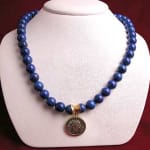Silver Denarius of Roman Emperor Trajan, 98 CE - 117 CE
Silver-Lapis Lazuli
FJ.5150
Further images
This stunning coin is set in a lovely 18 karat gold pendant, strung on a necklace of genuine carnelian beads, with an 18 karat gold clasp. C. Messius Quintus Trianus...
This stunning coin is set in a lovely 18 karat gold pendant, strung on a necklace of genuine carnelian beads, with an 18 karat gold clasp.
C. Messius Quintus Trianus Decius was born about 201 A.D. In lower Pannonia (now Hungary and Yugoslavia). He was governor of lower Moesia (southern Europe) from 234-238 A.D. Following the abortive rebellion of upper Moesia, Philip dispatched Decius to restore order; but the rebels forced the latter, under threat of death, to "assume the purple" and march upon Italy. In the ensuing battle Philip and his son were slain and Decius w as left undisputed master of the empire. Much of his short reign was spent in fighting the barbarians on the northern frontier and in a battle against the Goths in 251 A.D. Decius was defeated and killed. Unfortunately, the reign of Decius is best known for his rigorous persecution of the Christians, in which pope Fabian lost his life. Apart from Decius' own coins, and those of his wife and sons, he also struck a series of coins commemorating most of the deified emperors from Augustus to Severus Alexander.
Lapis is a rare metamorphic rock produced by the interaction of granite like magma with marble. With Chile being the primary source of the gemstone, it is no wonder that it was worked by the Incas in pre-Columbian times and continues to be produced in that country today. Lapis was also available in the old world. In Egypt, carved lapis lazuli beads, scarabs, pendants and inlaid jewelry date back to as early as 3100 B.C. esteemed as both a gem and an amulet, lapis was also ground into powder and used for medicinal and cosmetic purposes. Old world royalty adorned themselves with lapis. The tomb of queen Pu-Abi 2500 B.C. in the city of Ur in Summer contained adornments rich with lapis, including three gold headpieces and two bead necklaces. During the time of Confucius ca. 551-479 B.C. the Chinese carved lapis hair and belt ornaments. As early as the fourth century b.c. the Greeks used lapis for carving scarabs, while later in Rome lapis was fashioned into intaglios, plain ring stones, beads and inlays. The ancient Buddhists were aware of its curative powers, bringing the wearer peace of mind and equanimity. Lapis was also believed to dispel all evil thoughts.
C. Messius Quintus Trianus Decius was born about 201 A.D. In lower Pannonia (now Hungary and Yugoslavia). He was governor of lower Moesia (southern Europe) from 234-238 A.D. Following the abortive rebellion of upper Moesia, Philip dispatched Decius to restore order; but the rebels forced the latter, under threat of death, to "assume the purple" and march upon Italy. In the ensuing battle Philip and his son were slain and Decius w as left undisputed master of the empire. Much of his short reign was spent in fighting the barbarians on the northern frontier and in a battle against the Goths in 251 A.D. Decius was defeated and killed. Unfortunately, the reign of Decius is best known for his rigorous persecution of the Christians, in which pope Fabian lost his life. Apart from Decius' own coins, and those of his wife and sons, he also struck a series of coins commemorating most of the deified emperors from Augustus to Severus Alexander.
Lapis is a rare metamorphic rock produced by the interaction of granite like magma with marble. With Chile being the primary source of the gemstone, it is no wonder that it was worked by the Incas in pre-Columbian times and continues to be produced in that country today. Lapis was also available in the old world. In Egypt, carved lapis lazuli beads, scarabs, pendants and inlaid jewelry date back to as early as 3100 B.C. esteemed as both a gem and an amulet, lapis was also ground into powder and used for medicinal and cosmetic purposes. Old world royalty adorned themselves with lapis. The tomb of queen Pu-Abi 2500 B.C. in the city of Ur in Summer contained adornments rich with lapis, including three gold headpieces and two bead necklaces. During the time of Confucius ca. 551-479 B.C. the Chinese carved lapis hair and belt ornaments. As early as the fourth century b.c. the Greeks used lapis for carving scarabs, while later in Rome lapis was fashioned into intaglios, plain ring stones, beads and inlays. The ancient Buddhists were aware of its curative powers, bringing the wearer peace of mind and equanimity. Lapis was also believed to dispel all evil thoughts.





